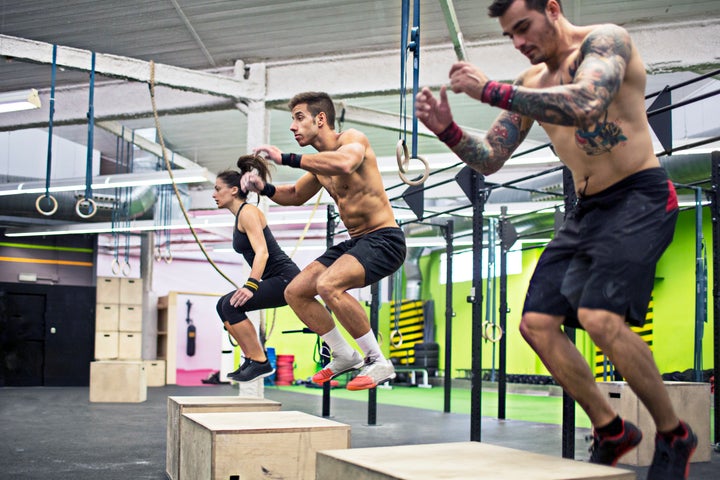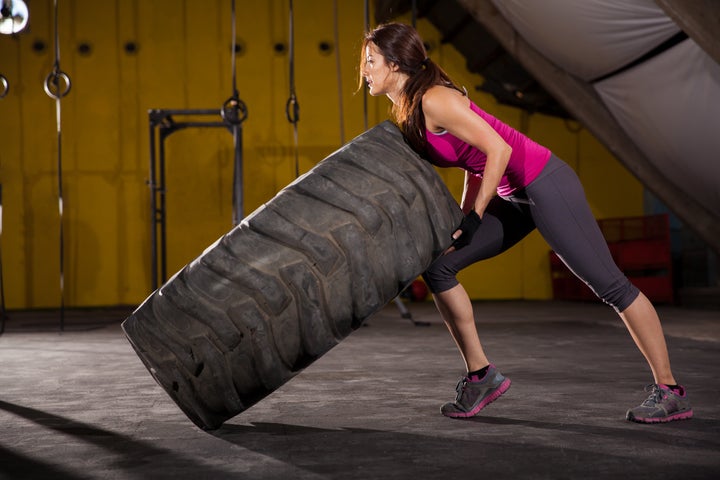You might not know exactly what CrossFit is - yet - but we can guarantee that hearing the word “CrossFit” will conjure up certain images.
Olympic-style weight lifting. Muscles - and dedication - like you’ve never seen. Paleo diets. Instagram #squadgoals. Grueling workouts. Did we mention muscles already?
The results it gives - both physical and mental - have inspired cult-like obsession, with hundreds of CrossFit gyms popping up across the country in the last few years.
Here’s what you need to know about CrossFit, from the exercises you can expect to the benefits you’ll experience and how to get involved. They don’t call it “punishing” for no reason...
What do you do in CrossFit classes?
CrossFit teams aerobic classes, cardio and Olympic weightlifting exercises to create an allover workout that helps you to move better.
“The basic instinct philosophy is that ‘the best athlete is somebody who can lift heavy weights and go long distances, quickly,’” says CrossFit London’s Andrew Stemler, London’s first CrossFit certified trainer.
“To go faster, more powerfully, you have to be able to move well and you need a diversity of training to help you through tasks you’ve done and things you’ve never done previously.”
According to Stemler, CrossFit gives you physical literacy that allows you to perform in a crisis or to go back in time and survive - you are developing multiple things at the same time so you have strong legs, arms and core, balance and agility, quick speed and a great engine, aka a cardiovascular capacity that can cope with variations in pace.
Greg Glassman, coach and founder of CrossFit, sums up the sport’s philosophy in 100 words:
- Eat meat and vegetables, nuts and seeds, some fruit, little starch and no sugar.
- Keep intake to levels that will support exercise but not body fat.
- Practice and train major lifts: Deadlift, clean, squat, presses, C&J, and snatch.
- Similarly, master the basics of gymnastics: pull-ups, dips, rope climb, push-ups, sit-ups, presses to handstand, pirouettes, flips, splits, and holds.
- Bike, run, swim, row, etc, hard and fast. Five or six days per week mix these elements in as many combinations and patterns as creativity will allow.
- Routine is the enemy. Keep workouts short and intense.
- Regularly learn and play new sports.
The idea is to mix and match all of the moves you learn in as many different styles as possible, with no specific objective in mind necessarily.
“It’s almost like primary school for fitness At the end of primary school, you should be able to read, write, do some geography and maths,” says Stemler.
“Physicality is not just about running 5K really fast. If you were a normal human being who had to survive, you’d want to lift groceries while sprinting 500m, run 5K, etc. ”

This sounds intense. Can beginners do it?
The good news is that you can ease your way up to this. On beginner courses, students practice with a PVC pipe which weighs next-to-nothing to do the weightlifting exercises.
“If you’re an absolute catastrophe who’s been hunched over your desk 12 hours a day, and drink, those sessions are the worst you’ve ever had in your life,” says Stemler.
Beginner courses create a base of literacy for students, and consist of seven hours of basic CrossFit fundamentals training before you can move into mainstream classes. This is designed in a way to minimise the risk of injury and ensure maximum safety for all participants.
CrossFit classes begin with a warm-up and then typically focuses on a specific activity per session (barbell strength and/or skills like squats or kettlebell swings). There is also a WOD - workout of the day - which changes day to day. Each CrossFit class is 60 minutes, and there is plenty to tempt the novice: ropes and rings for suspended gymnastics, tyres and prowlers for Strongman exercises, poles, kettle bells and dumbbells for lifting, as well as jump ropes and pull-up bars.
“A big source of complaint is, ‘Why can’t I go into class?’” says Stemler. “We have to fight to stop people going into class before they’re ready.”
In CrossFit, there are constantly new skills to add to your repertoire and those who take a keen interest in the sport can even move onto competition classes - CrossFit competitions are the ultimate test of fitness - after a couple of years. Or you can choose to specialise in lifting or gymnastics a bit more, if you take a fancy to a particular aspect of the class.
What are the benefits?
Like other HIIT (high-intensity interval training) exercises, CrossFit offers cardio benefits, as well as helping participants lose weight and amass muscle. The diverse exercises are also useful in helping both to strengthen and condition the body, and the challenge format of the workouts turns it into a mini-competition with yourself which you aren’t likely to get bored by. There are also the positive mental benefits that come from exercising, and in Stemler’s view, “there is a connection between the intellectual component of CrossFit - the more your mind is attuned and responding to challenges, the more your body is inclined to.”
Another benefit of CrossFit comes from the #squadgoals the sport inspires: while everyone is pursuing their own individual path, it is about the shared experience of being together and helping each other out.
Since there are typically 10-12 people in a class, doing different things in mini-groups, everyone is helping everyone else by participating as a spectator. Sometimes, more advanced students help the less advanced.
“Everything can be varied but they’re all doing the same sort of thing,” says Stemler. “Everyone has worked as hard as they can - relatively they’ve shared the experience, shared a commonality that seems to boost our training method. It’s great for getting people to socialise during the class.
“It’s the best thing I’ve ever done and I’ve done everything from martial arts to swimming to running to boxing.
“If you enjoy working hard and know that success in life comes from working hard, you’ll find a home in CrossFit. As long as you have the mentality that ‘I am OK with failing in public and not being intimidated,’ everyone just works together and gets on.”

Anything else I need to know before starting?
If you’re looking for a CrossFit gym, Stemler says the most important factor to consider is proximity.
“Find the one that’s nearest to you as you can get to. Sometimes there is a particular box that caters to your needs, but don’t worry about people who produce teams. CrossFit has now been overlaid by being a competitive regime. Find a local place, not a place trying to produce an elite athlete.”
There’s also some lingo you should learn before hitting the gym:
Box: the gym. A mini school driving quality and movement, upping your skill and capacity level.
WOD: workout of the day
EMOM: every minute on the minute
AMRAP: as many rounds as possible (in a given time frame)
RFT: rounds for time - you are given a series of tasks to do as quickly as possible (in CrossFit, you program exercises as a time priority, like an AMRAP, or as a work priority, RFT)